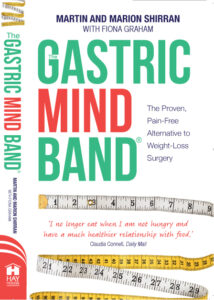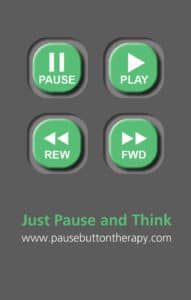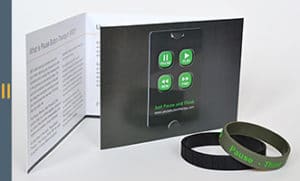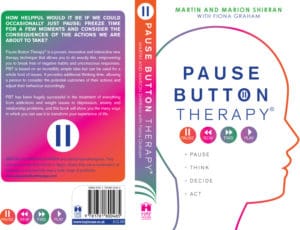The History of Pause Button Therapy
History of Pause Button Therapy. During 2005 at a small, British owned clinic in Fuengirola, Southern Spain, two therapists, Martin & Marion Shirran, formulated and registered a new approach/method to weight loss. They called it "The Gastric Mind Band". This innovative approach then went on to attract unprecedented levels of worldwide publicity and interest, exceeding all expectations. The Gastric Mind Band has featured many times in magazines, newspapers and in TV interviews in both the UK and the USA. The Shirrans' GMB therapy is now the subject of the book, "The Gastric Mind Band," published by Hay House. You can also visit the Gastric Mind Band website for more information. The History of Pause Button Therapy.
During the development phase a new therapy evolved. This happened when they combined Cognitive Behaviour Therapy, Neuro Linguistic Programming, Hypnotherapy and Guided Imagery. Each of these techniques was used to underpin the other, and they named their new methodology 'Life Architecture Therapy'. This name perfectly summed up what they were striving to help their clients achieve; to truly become the 'Architect Of Their Life' going forward.
The History of Pause Button Therapy
The treatment was, and remains, the subject of ongoing research, and is constantly evolving. Then the couple became aware that they needed an additional component in their Gastric Mind Band therapy. This element would help to further increase the level of successful outcomes. They wanted a method whereby the client could visually and mentally freeze time. This in turn would give clients the opportunity to really consider the outcomes and consequences of their planned actions. And so, this was the initial 'seed' of the Pause Button Therapy. The History of Pause Button Therapy.
This new component of the treatment proved to be the perfect tool. Its success exceeded all expectations, enabling dieters to literally 'freeze' time, before they sabotaged their efforts. Next, a visual aid, a tangible device was necessary, so clients could continue to build on what they had learnt in therapy. So they created the Pause Button Card, which specifically looks and feels like a traditional Credit Card. A short time later, they also designed silicone wrist bands, with the symbols of a remote control 'de-bossed' into them. Clients are encouraged to wear the silicone device on their dominant wrists, so that the band is always visible. From the outset, clients seemed to like the fact that this was a part of therapy that they could see, touch and feel.
The History of Pause Button Therapy
Everything else regarding the Gastric Mind Band Therapy is history. It has achieved widespread interest on both sides of the Atlantic. Incidentally, this level of publicity is normally the restricted domain of the multi-million pound Pharmaceutical Organisations. However, this was actually only the beginning of the story, not the end. Because, when time allowed, they continued to see clients with problems other than those around weight issues. This included problems such as addictions and those suffering from panic attacks for example.
Once again, more by accident than design, a new situation developed. A client having sessions with Martin to overcome his anger management problem, arrived at the clinic for his weekly visit. During the session, he picked up a Pause Button Card that had been left on the coffee table by the previous client, and asked what it was. Martin then explained how it was used in weight loss, and how it could possibly be used in other areas of treatment. The client then asked if he could keep it. When he returned the following week, reporting how useful it had been, it was the start of a new journey. And, from that moment on, a brand new stand alone therapy was established.
How Pause Button Therapy Started
Sometimes in desperation, Martin started to incorporate Pause Button Therapy into the treatment plan of clients arriving at the clinic with a range of other conditions. For instance, it was successfully used with clients suffering from cocaine addiction and panic attacks. It also worked surprisingly well with couples who needed relationship counselling. Over the years, Pause Button Therapy has gradually become an integral part of many different therapy sessions, including stop smoking, bulimia, depression, road rage and OCD. It has successfully filled a real gap in available therapeutic approaches. And, as a result, clients can easily learn how to 'stop' and maybe for the first time really consider the implications of the actions they were about to undertake. History of Pause Button Therapy.
Pause Button Therapy
The therapy also works particularly well with young patients. Children effortlessly grasped the concept. Also, the idea of using a DVD player remote control to freeze time, required very little explanation. As an example it was used with children troubled by issues around truancy, bullying and anger. Informal discussions with therapists of various disciplines highlighted a real interest in the approach. Consequently, there was universal agreement that there was a real need and place for an approach such as this that the user could instantly understand.
PBT was included in two separate University Psychology Conference Presentations. It has also featured in the national media in its own right. To enable a greater global availability of the approach, the new PBT Therapist Training Manual is now available as a downloadable PDF document. The training manual also includes the Client Work Book.
The History of Pause Button Therapy
Martin and Marion Shirran signed a multi-title publishing contract with the leading 'Mind, Body' publishers, Hay House, and their second book, Pause Button Therapy, was published in 2012. Professor Philip Zimbardo, of Stanford University, wrote the foreword to the second edition.
Pause Button Therapy/TactileCBT is for anyone who’s ever made a mistake in their life and never wants to make one again. It's for anyone who wants to make a change.
Pause Button Therapy/TactileCBT Blog
Keep up to date with the latest news and trends about Pause Button Therapy and TactileCBT by visiting our Blog page. New in-depth info is added periodically, so make sure you bookmark the page and visit regularly. Click here to see what everyone is talking about. Feel free to also share the link with your friends.
Contact Us
If you require any additional information around Pause Button Therapy and Tactile CBT, the PBT Cards and Wrist Bands, Work Books, or the new Therapists Training Manual, email us today. We will be pleased to answer any outstanding questions you may have. We look forward to hearing from you soon and maybe helping you change your life, or, of course, assisting you to help others.














